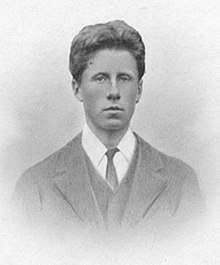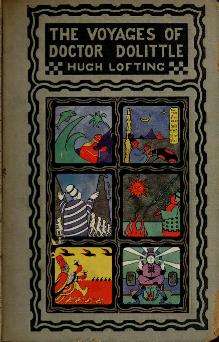Hugh Lofting
Hugh John Lofting (14 January 1886 – 26 September 1947) was an English author trained as a civil engineer, who created the classic children's literature character of Doctor Dolittle.[1] It first appeared in illustrated letters to his children written by Lofting from the British Army trenches in World War I.
Hugh Lofting | |
|---|---|
 Lofting as a young man | |
| Born | Hugh John Lofting 14 January 1886 Maidenhead, Berkshire, England |
| Died | 26 September 1947 (aged 61) Topanga, California, U.S. |
| Occupation | Novelist, Poet |
| Genre | Children's literature, Fantasy |
| Notable works | Doctor Dolittle |
| Notable awards | Newbery Medal 1923 |
| Relatives | Hilary Lofting (brother) |
| Military career | |
| Allegiance | |
| Service/ | British Army |
| Years of service | 1914–1918 |
| Unit | Irish Guards |
| Battles/wars | World War I |
Personal life
Lofting was born in January 1886 in Maidenhead, Berkshire, to Elizabeth Agnes (Gannon) and John Brien Lofting.[2] He was of English and Irish ancestry. His eldest brother was Hilary Lofting, who later became a novelist in Australia, having emigrated there in 1915.
Lofting was educated at Mount St Mary's College in Spinkhill, Derbyshire. From 1905 to 1906 he studied civil engineering at the Massachusetts Institute of Technology, Cambridge, Massachusetts.[3][4]
He travelled widely as a civil engineer before enlisting in the Irish Guards regiment of the British Army in World War I. Not wishing to write to his children about the brutality of the war, he wrote imaginative letters which later became the foundation of the successful Doctor Dolittle novels for children. Seriously wounded in the war, in 1919 Lofting moved with his family to Killingworth, Connecticut.[5] He was married three times and had three children, one of whom, his son Christopher, is the executor of his literary estate.
Doctor Dolittle

Hugh Lofting's character Doctor John Dolittle, an English physician from Puddleby-on-the-Marsh in the West Country, who could speak to animals, first saw light in the author's illustrated letters to children, written from the trenches during the 1914–1918 War, when actual news, he later said, was either too horrible or too dull. The stories are set in early Victorian England in the 1820s–1840s (The Voyages of Doctor Dolittle gives a date of 1839). He was living in Killingworth, Connecticut, while he wrote most of the instalments to the series.[6]
The Story of Doctor Dolittle: Being the History of His Peculiar Life at Home and Astonishing Adventures in Foreign Parts Never Before Printed (1920) began the series and won the Lewis Carroll Shelf Award in 1958. The sequel The Voyages of Doctor Dolittle (1922) won Lofting the prestigious Newbery Medal. Eight more books followed, and after Lofting's death two more appeared, composed of short previously unpublished pieces.
The internal chronology of the books is somewhat different from the publishing order. The first book is followed by Doctor Dolittle's Post Office (1923), Doctor Dolittle's Circus (1924) and Doctor Dolittle's Caravan (1926). Only then follows the second book, The Voyages of Doctor Dolittle (1922), continued by Doctor Dolittle's Zoo (1925). After that, the publishing order is restored; Doctor Dolittle's Garden (1927) is followed by Doctor Dolittle in the Moon (1928) and Doctor Dolittle's Return (1933), ending with Doctor Dolittle and the Secret Lake (1948).[6]
Other works for children
The Story of Mrs Tubbs (1923) and Tommy, Tilly, and Mrs. Tubbs (1936) are picture books aimed at a younger audience than the Doctor Dolittle books. They are about the old woman of the title and her pets, with whom she can speak, and the animals who help her out of trouble.
Porridge Poetry (1924) is the only non-Dolittle work by Lofting still in print. It is a lighthearted, colorfully illustrated book of poems for children. Noisy Nora (1929) is a cautionary tale about a girl who is a noisy eater. The book is printed as if hand-written, and the many illustrations often merge with the text.
The Twilight of Magic (1930) is aimed at older readers. It is set in an age when magic is dying and science is beginning. This work is the only one of Lofting's books to be illustrated by another person (Lois Lenski).[6]
Victory for the Slain
Victory for the Slain (1942) is Lofting's only work for adults. It consist of a single long poem in seven parts about the futility of war, permeated by the refrain "In war the only victors are the slain." It was published only in the United Kingdom.[6]
Works
Lofting commented, "For years it was a constant source of shock to me to find my writings amongst 'juveniles'. It does not bother me any more now, but I still feel there should be a category of 'seniles' to offset the epithet."[6]
- The Story of Doctor Dolittle (1920) ISBN 978-0099427322
- The Voyages of Doctor Dolittle (1922) ISBN 978-0099854708
- Doctor Dolittle's Post Office (1923) ISBN 978-0099880400
- The Story of Mrs Tubbs (1923)
- Doctor Dolittle's Circus (1924) ISBN 978-1612035390
- Porridge Poetry (1924)
- Doctor Dolittle's Zoo (1992, mass-market paperback) ISBN 978-0-09-988030-1 (1925, hardcover) ISBN 978-0-397-30009-9
- Doctor Dolittle's Caravan (1992, mass-market paperback) ISBN 978-0-09-985450-0 (1926, hardcover) ISBN 978-0-397-30011-2
- Doctor Dolittle's Garden (1927) ISBN 978-0099880509
- Doctor Dolittle in the Moon (1928) ISBN 978-0099880608/978-1612035369
- Noisy Nora (1929)
- The Twilight of Magic (1930)
- Gub Gub's Book: An Encyclopedia of Food (1932)
- Doctor Dolittle's Return (1933) ISBN 978-0-09-988070-7
- Doctor Dolittle's Birthday Book (1936)
- Tommy, Tilly, and Mrs. Tubbs (1936)
- Victory for the Slain (1942)
- Doctor Dolittle and the Secret Lake (1948) ISBN 978-0099880806
- Doctor Dolittle and the Green Canary (1950) ISBN 978-1406763393
- Doctor Dolittle's Puddleby Adventures (1952) OCLC 1185760 ISBN 978-0-14-030409-1
References
- "Hugh Lofting". Encyclopædia Britannica Online. Retrieved 19 December 2009.
- https://lofting.thefreelibrary.com/
- "Register of Students" (PDF). Bulletin of the Massachusetts Institute of Technology. 41 (1): 386. December 1905. Archived (PDF) from the original on 6 September 2015. Retrieved 25 July 2017.
- "150 Years in the Stacks – Year 60 – 1920: The Story of Doctor Dolittle by Hugh Lofting". Massachusetts Institute of Technology Libraries. Archived from the original on 29 November 2015. Retrieved 25 July 2017.
- Pietrzyk, Cindi. Connecticut Off the Beaten Path, p. 157 (Globe Pequot, 2013).
- Schmidt, G. D.(1992). Hugh Lofting. New York: Twayne Publishing.
External links
| Wikisource has original works written by or about: Hugh Lofting |
- Works by Hugh Lofting at Project Gutenberg
- Works by Hugh Lofting at Faded Page (Canada)
- Works by or about Hugh Lofting at Internet Archive
- Works by Hugh Lofting at LibriVox (public domain audiobooks)

- A Hugh Lofting website
- First Editions UK – with images
- Hugh Lofting at Library of Congress Authorities, with 89 catalog records
| Awards | ||
|---|---|---|
| Preceded by Hendrik Willem Van Loon |
Newbery Medal winner 1923 |
Succeeded by Charles Hawes |